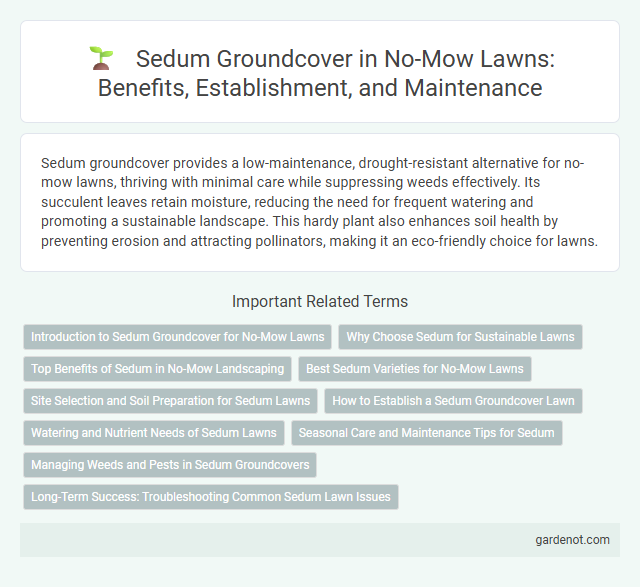Sedum groundcover provides a low-maintenance, drought-resistant alternative for no-mow lawns, thriving with minimal care while suppressing weeds effectively. Its succulent leaves retain moisture, reducing the need for frequent watering and promoting a sustainable landscape. This hardy plant also enhances soil health by preventing erosion and attracting pollinators, making it an eco-friendly choice for lawns.
Introduction to Sedum Groundcover for No-Mow Lawns
Sedum groundcover is an ideal choice for no-mow lawns due to its drought tolerance and low maintenance requirements. This succulent plant forms a dense, carpet-like mat that suppresses weeds and thrives in poor soil conditions, reducing the need for watering and mowing. Sedum species such as Sedum rupestre and Sedum album are popular for their vibrant foliage and ability to withstand foot traffic, making them perfect for sustainable, eco-friendly landscaping.
Why Choose Sedum for Sustainable Lawns
Sedum groundcover offers exceptional drought tolerance and requires minimal maintenance, making it ideal for sustainable lawns. Its thick, succulent leaves store water efficiently, reducing irrigation needs significantly while preventing soil erosion. Sedum's ability to thrive in poor soils with little fertilizer supports eco-friendly landscaping by minimizing chemical inputs.
Top Benefits of Sedum in No-Mow Landscaping
Sedum groundcover offers exceptional drought tolerance and requires minimal maintenance, making it ideal for no-mow landscaping. Its ability to thrive in poor soil conditions reduces the need for fertilizers and watering, promoting sustainable gardening. Sedum's dense mat formation suppresses weeds effectively, enhancing garden aesthetics without frequent mowing.
Best Sedum Varieties for No-Mow Lawns
Sedum groundcovers like Sedum album, Sedum spurium, and Sedum reflexum are ideal for no-mow lawns due to their drought tolerance, low maintenance, and spreading growth habit. These varieties create a dense, evergreen carpet that suppresses weeds and requires minimal watering, making them perfect for sustainable landscaping. Their ability to thrive in poor soil conditions enhances eco-friendly lawn alternatives, reducing the need for mowing and irrigation.
Site Selection and Soil Preparation for Sedum Lawns
Sedum groundcover thrives in well-drained, sandy or rocky soils with full sun exposure, making site selection critical for a successful no-mow lawn. Removing existing vegetation and loosening the soil to a depth of 4-6 inches enhances root establishment and drainage. Incorporating coarse sand or small gravel improves soil texture, promoting Sedum's drought tolerance and long-term health.
How to Establish a Sedum Groundcover Lawn
Establishing a sedum groundcover lawn begins with selecting drought-tolerant sedum varieties such as Sedum acre or Sedum spurium, known for their low maintenance and vibrant foliage. Prepare the soil by ensuring well-drained, sandy or gravelly substrates, then plant sedum cuttings or plugs in full sun to maximize growth and coverage. Regular watering during the initial establishment phase promotes root development, while minimal mowing or trimming maintains the dense, weed-resistant mat that characterizes sedum lawns.
Watering and Nutrient Needs of Sedum Lawns
Sedum lawns require minimal watering, thriving in well-drained soils with infrequent moisture once established, making them ideal for drought-prone areas. These succulent groundcovers absorb nutrients efficiently from poor soil conditions, reducing the need for additional fertilization. Properly managed Sedum lawns maintain vibrant growth with low water consumption and minimal nutrient input, ensuring sustainable and low-maintenance landscaping.
Seasonal Care and Maintenance Tips for Sedum
Sedum groundcover requires minimal seasonal care, thriving in well-drained soil with full sun exposure. In spring, remove any debris and trim back dead stems to encourage new growth, while occasional watering during extended dry periods supports plant health. Sedum's drought tolerance reduces the need for frequent watering, and dividing clumps every few years helps maintain dense, healthy coverage.
Managing Weeds and Pests in Sedum Groundcovers
Sedum groundcovers naturally suppress many weeds due to their dense, low-growing foliage, reducing the need for herbicides in no-mow lawns. Mulching around sedum patches can further inhibit weed emergence while maintaining moisture, which also deters common pests such as aphids and spider mites. Regularly inspecting plants and using organic insecticidal soaps or neem oil helps control infestations without harming beneficial insects in the Sedum ecosystem.
Long-Term Success: Troubleshooting Common Sedum Lawn Issues
Sedum groundcover guarantees long-term success by thriving in well-drained, nutrient-poor soils that resist weed invasion and drought stress. Troubleshooting common Sedum lawn issues involves addressing poor drainage, overwatering, and insufficient sunlight, which cause root rot and slow growth. Regular inspection for pests like aphids and maintenance of proper soil conditions ensure a vibrant, sustainable no-mow lawn.
Sedum groundcover Infographic

 gardenot.com
gardenot.com